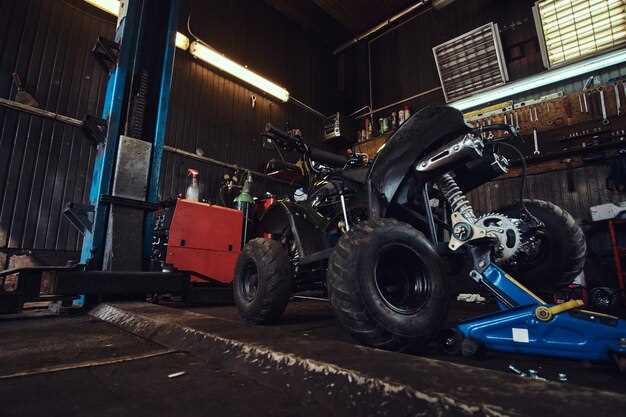Choosing the right suspension system is key to enhancing your off-road vehicle’s performance. A well-designed suspension allows for increased articulation, ensuring all wheels maintain contact with the ground when traversing rocky or uneven surfaces. This improved grip translates to better traction, crucial for overcoming challenging terrains.
Consider investing in systems that offer adjustable dampening features. These systems enable you to tailor your suspension settings based on the terrain type. Softer settings can absorb the shocks of rocky trails, while firmer settings can provide added stability on smoother pathways. This adaptability enhances comfort and control during off-road excursions.
Another factor to keep in mind is ground clearance. Suspension systems that raise your vehicle’s height not only improve visibility but also reduce the risk of underbody damage on rugged landscapes. Elevating your ride can allow for larger tires, which further improves off-road capability by increasing traction and navigating obstacles with ease.
Lastly, opting for a system with robust shock absorbers is essential. Quality shocks reduce bounce and maintain stability, enhancing your off-road experience. Selecting the right suspension dramatically impacts your vehicle’s ability to conquer diverse terrains, making it a fundamental component in off-road adventures.
Understanding the Role of Suspension in Off-Road Performance
A well-designed suspension system significantly influences off-road capabilities. Proper suspension increases wheel travel, enabling vehicles to maneuver over obstacles without losing traction. Aim for a system that balances flexibility and stability to tackle rough terrains effectively.
Wheel articulation is crucial for maximizing grip on uneven surfaces. Independent suspension systems generally offer better articulation compared to solid axles, allowing for improved contact with the ground. When selecting a suspension, consider features like adjustable dampers and coil springs. These allow drivers to tailor settings based on specific terrain types, enhancing overall performance.
Pay attention to ground clearance as well. A suspension system that provides sufficient lift enables vehicles to clear larger obstacles and reduces the risk of undercarriage damage. However, excessive lift can affect handling and road stability. Balance is key; maintain a moderate increase in height to achieve optimal versatility.
Shock absorbers play a pivotal role in managing how suspension interacts with the terrain. High-quality shocks absorb impact, providing a smoother ride over bumps and troughs. Look for shocks with adjustable settings for compression and rebound, which let you adapt to various off-road challenges.
Here’s a comparison of some common suspension types used in off-road vehicles:
| Suspension Type | Advantages | Disadvantages |
|---|---|---|
| Independent Suspension | Better wheel articulation, improved handling | Typically more expensive, may have lower durability |
| Solid Axle Suspension | High durability, easier to repair | Limited wheel travel, may struggle with stability |
| Coil Spring Suspension | Good ride quality, adjustable height | Can be less durable under extreme conditions |
Regular maintenance is equally significant. Check for wear and tear on components such as bushings and joints, which can compromise performance. Inspect shocks for leaks or damage, ensuring optimal functioning during off-road excursions. Regular cleanings of the suspension system, especially after muddy trips, will prolong its lifespan.
In summary, focus on a balanced suspension system tailored to your off-road needs. Prioritize wheel travel, ground clearance, and quality shock absorbers for peak performance across various terrains. Maintain the system diligently to ensure consistency in your off-road adventures.
Types of Suspension Systems and Their Off-Road Benefits
Consider multi-link suspension for enhanced flexibility and wheel articulation. This design allows each wheel to react independently to terrain obstacles, improving traction on uneven surfaces. Vehicles equipped with multi-link systems can more easily maintain contact with the ground when traversing rocky or rugged trails.
Leaf spring suspension provides durability and load-bearing capacity, making it a solid choice for off-road vehicles. This setup excels in absorbing shocks from heavy loads and rough terrain, delivering a reliable experience during off-road excursions. Leaf springs also contribute to higher ground clearance, reducing the risk of undercarriage damage.
For superior shock absorption and adaptability, explore coil spring suspension. Coil springs compress and expand smoothly, allowing for better control over bumps and dips. This system keeps the vehicle stable, ensuring a comfortable ride while maintaining traction on loose surfaces like sand or mud.
Long-travel suspension systems maximize wheel movement, which greatly aids in overcoming large obstacles. These systems allow the suspension to compress and extend further than standard setups, promoting better handling and stability during steep climbs or descents.
Active suspension uses sensors and electronic controls to adjust the damping in real-time. This technology optimizes ride quality by adapting to changing conditions, ensuring maximum traction and stability. It significantly enhances performance on varied terrains, allowing drivers to tackle harsh conditions with confidence.
For vehicles intended for extreme off-road performance, air suspension provides adjustable ride height and firmness. Users can modify the suspension settings based on the terrain, promoting adaptability. Whether navigating rocks or driving on sand, air suspension can be tailored for the best results.
Choosing the right suspension system directly impacts off-road capabilities. Assess your specific driving needs and the types of terrain you encounter to select the most beneficial system for your vehicle.
How Suspension Geometry Affects Traction and Stability
Optimize suspension geometry for better traction and stability on off-road terrain. Increasing the wheelbase enhances stability, distributing weight more evenly across the tires. This setup reduces the likelihood of tipping during sharp turns or over uneven surfaces, providing drivers with a greater sense of control.
Adjust camber angles to improve tire contact with the ground. A negative camber angle allows the tires to maintain better grip during cornering, which is crucial on off-road paths. Balance this with appropriate toe settings to ensure the vehicle tracks straight without sacrificing cornering performance.
The relationship between suspension travel and ground clearance cannot be overstated. Increased suspension travel allows for greater articulation, improving the vehicle’s ability to keep tires in contact with the ground. This is essential for maintaining traction on rocky or uneven surfaces where one wheel may lift off the ground.
Additionally, consider the role of damping characteristics in suspension systems. Tuned properly, dampers can control body movement and keep the vehicle stable through rough terrain, allowing for better handling and minimizing loss of traction. Adjust damping settings to suit specific riding conditions and vehicle loads.
Implementing a multi-link suspension design can significantly enhance off-road capabilities. This configuration allows for better wheel articulation and improved alignment of the tires with the ground. A well-designed multi-link system can better absorb shocks while maintaining grip, which is particularly beneficial when navigating obstacles.
Monitoring suspension geometry, such as ride height and roll center, is essential for optimizing off-road performance. Lower the center of gravity to reduce body roll, enhancing stability in turns. Keep in mind the trade-off between ride comfort and performance; ensure adjustments align with specific terrain types while maintaining driver comfort.
Regular maintenance and fine-tuning of the suspension system will maximize traction and stability benefits. Replace worn components and adjust settings based on usage patterns to ensure the vehicle performs optimally during challenging off-road conditions.
Maintenance Tips for Optimizing Suspension in Off-Road Vehicles
Inspect shock absorbers regularly for signs of leaks or damage. Replace them if they show any wear, as this directly affects handling and comfort on rough terrain.
Check and maintain proper tire pressure based on manufacturer recommendations. Under-inflated or over-inflated tires can compromise suspension performance and traction on the trail.
Regularly clean and lubricate suspension bushings and joints to prevent wear and reduce noise. Use appropriate grease to ensure smooth operation and longevity of components.
Examine the suspension geometry frequently. Look for sagging or misalignment, which can lead to uneven tire wear and diminished off-road performance. Adjustments may be necessary to maintain correct angles.
Replace worn-out springs to enhance load-bearing capacity and improve stability. Consider upgrading to heavy-duty springs if you often carry extra loads or tackle challenging terrain.
Check the mounting hardware for signs of corrosion or looseness. Tighten any loose bolts and replace corroded parts to maintain integrity and safety while off-roading.
Conduct regular inspections of the undercarriage to identify any damage from obstacles. Repair any issues promptly to prevent them from exacerbating suspension problems down the line.
Invest in quality skid plates to protect suspension components from rocks and debris. This adds an extra layer of security and helps maintain suspension performance in rugged conditions.
Flush and refill any dampening fluids as recommended by the manufacturer. Fresh fluids maintain optimal damping characteristics and prolong the lifespan of your shocks.
Keep an eye on the overall weight distribution of your vehicle. Uneven loads can strain suspension components, so adjust as needed for balanced performance.
Aftermarket Modifications: Choosing the Right Suspension Upgrades
Consider upgrading to coilover kits for enhanced adjustability and improved off-road performance. These kits allow you to customize ride height and damping settings, catering to specific terrains you frequently encounter.
Leaf spring upgrades are another excellent choice for increased load capacity and durability, particularly for larger vehicles that tow heavy loads. Look for heavy-duty leaf springs designed specifically for off-road use to improve stability and handling.
Adding shock absorbers can dramatically improve your ride quality and vehicle control. Focus on high-performance shocks with adjustable settings to fine-tune your suspension for varied conditions.
- Gas shocks: Generally provide better performance and durability over traditional oil shocks.
- Remote reservoir shocks: Offer increased cooling capacity and additional damping options.
Installing anti-sway bars can enhance cornering stability and reduce body roll. They are particularly beneficial for vehicles that frequently navigate rocky or uneven trails.
Upgrade your suspension bushings to enhance articulation and reduce friction. Consider polyurethane bushings, which provide better longevity and performance compared to stock rubber options.
Lastly, balance your modifications with your vehicle’s weight and purpose. Consider factors like tire size and differential gearing, as these can affect overall performance and handling greatly.
Consult with experts or mechanics specializing in off-road vehicles to ensure the modifications align with your requirements, enhancing your capabilities on rugged terrains.
Real-World Testing: Suspension Systems in Challenging Terrain
Choosing the right suspension system ensures optimal performance on rugged surfaces. Comprehensive testing under real-world conditions reveals how various systems respond to specific challenges. Here are key observations and recommendations based on practical experiences.
First, consider the type of terrain:
- Rocky Paths: Systems with high clearance and flexible articulation fare better. Look for suspensions with advanced coil springs that adapt to uneven surfaces.
- Mud and Wet Conditions: Incorporate a suspension with good damping capabilities. This reduces bounce and maintains contact with the ground, enhancing control and traction.
- Sandy Dunes: Opt for a suspension setup that allows for longer travel. A long-travel suspension keeps the wheels on the ground while absorbing shocks from sudden dips.
Testing setups should also mimic real-life scenarios:
- Load Trials: Equip your vehicle with various weights. Assess how the suspension system performs under differing loads to determine its capacity and stability.
- Obstacle Courses: Create a course with diverse challenges–steep inclines, sharp turns, and deep ruts. Monitor the vehicle’s handling and the suspension’s response throughout.
- Speed Tests: Evaluate performance at varying speeds. A reliable suspension maintains control and reduces body roll during high-speed maneuvers.
Finally, documentation of findings proves beneficial. Note the performance metrics during each test and identify any weaknesses. Continuous refinement based on test results enhances overall off-road capability. Selecting and testing the suspension system thoughtfully maximizes your vehicle’s potential across different challenging terrains.







